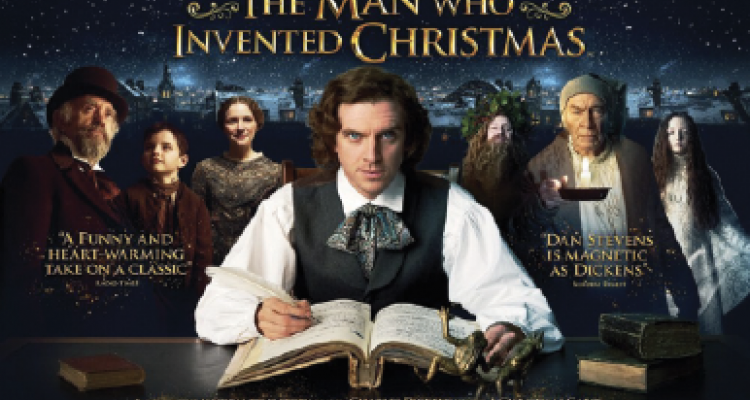If you’re one of those people who starts listening to Christmas music as soon as the last of the Thanksgiving leftovers are consumed and have already begun drinking hot chocolate and watching Christmas movies, then you’re in luck this holiday season. The Christmas movie of the season arrived in the midst of Thanksgiving celebration, premiering Wednesday, Nov. 22, plunging Christmas fanatics (like myself) into the holiday spirit right off-the-bat.
“The Man Who Invented Christmas” tells the backstory behind one of the most famous Christmas tales of all time — “A Christmas Carol,” written by Charles Dickens, walking the audience through the arduous process Dickens (Dan Stevens) went through to produce this well-known story while also coping with complications in his own life.
Directed by Bharat Nalluri (“Spooks: The Greater Good”) the film begins in 19th century London, where Dickens and his wife Kate Dickens (Morfydd Clark) are raising their 10 children. The family appears to be living lavishly, as any well-known author would, amid looming financial difficulties Dickens discusses at the beginning of the movie with his business partner, John Forster (Justin Edwards), after failing to publish a highly acclaimed novel in years. Struggling to find an idea for a new story for some time, Dickens finds inspiration in a story his children’s new nanny, Tara (Anna Murphy) tells of spirits that visit overnight, and sets to work on one of his most well-received tales.
Dickens does encounter several difficulties along the way, most prominently that his novel must be published by Christmas, and it’s already mid-October when he begins. However, the author finds inspiration for the characters in his tale among many of his family members and friends, which helps the story quite literally come to life for Dickens and the audience. Perhaps the most obvious and prevalent connection between the characters in “A Christmas Carol” and Dickens’ own life is between himself and Ebenezer Scrooge (Christopher Plummer). Dickens’ obsession with money and finances is evident from the start, as the majority of his conversations have to do with ways to earn and save money, even snapping at his wife at one point for wasting perfectly good candlesticks, closely mirroring Scrooge’s own fixation on money and his greedy nature. In this way, “A Christmas Carol” becomes not only a journey through the three ghosts — of Christmas past, present and future — with Scrooge, but Dickens’ own journey to discover the true meaning of Christmas and life itself.
It’s not difficult to find the inspirations behind other popular characters in “A Christmas Carol.” Tiny Tim, the character garnering the most sympathy for his deathly illness that the impoverished family struggles to finance, clearly resembles Dickens’ own nephew, who also suffers a terrible illness, as he has a crutch nearly identical to Tiny Tim’s, and is hoisted onto his father’s shoulder just as Scrooge’s clerk, Bob Cratchit, famously carried Tiny Tim in the story.
The connection drawn between Dickens’ father, John Dickens (Jonathan Pryce), and Jacob Marley, Scrooge’s dead business partner who comes to him in a dream to warn him of the dangers of leading a greedy and self-serving life, is indicative of the struggles Dickens endured his entire life with his father. The film highlights the money issues John Dickens has been plagued by his whole life, as he constantly spends too much money on unnecessary purchases (like a raven that knocks down Dickens’ chandelier). Later on, Dickens takes us inside his childhood tension with his father while experiencing the ghost of Christmas past, as his father’s debt had him arrested and forced Charles into becoming a factory boy, a traumatic experience that he was embarrassed by, serving as the author’s inner demon. Marley’s goal of convincing Scrooge to refrain from living his life in such a greedy manner can be compared to the way in which Charles learned from his father’s failures and money issues.
Not only does “The Man Who Invented Christmas” take audiences inside the inspirations Dickens injected into his story, but it shows just how crucial character development is in all of Dickens’ stories, as Dickens’ characters literally come to life in the film, instructing the author how his novel ought to proceed. Dickens watches as Scrooge and other characters yell at him for attempting to kill off Tiny Tim at the end, and try and convince him that even a miserly character like Scrooge can transform overnight and realize the true meaning of Christmas before it’s too late. In this way, the movie takes audiences inside a writer who clearly immersed himself in the lives of his characters, letting them dictate their own fates instead of the other way around.
The glimpse inside Dickens’ life that “The Man Who Invented Christmas” gives viewers shows not only the unique writing process of a famed author, but the journey this author went through along with his characters to realize the true meaning of Christmas and discover what truly matters in life — not money, but loving bonds with family and friends.
4.5/5 stars


Leave a Reply